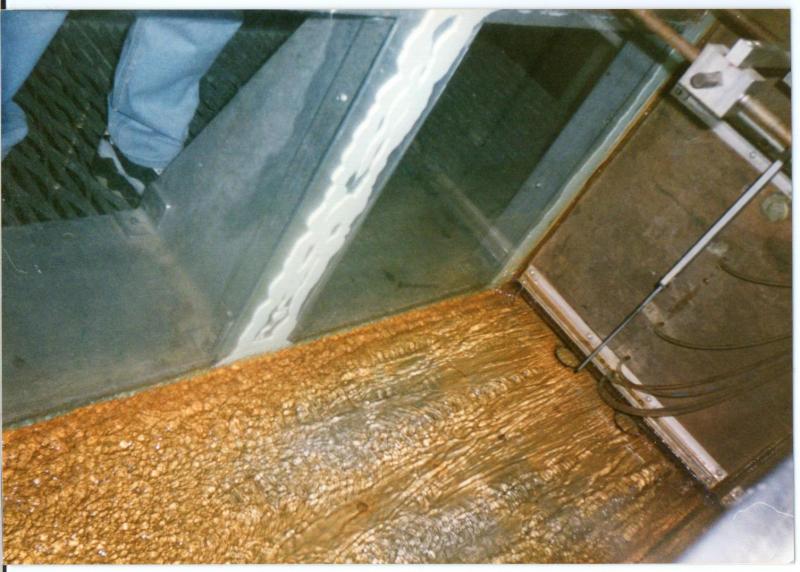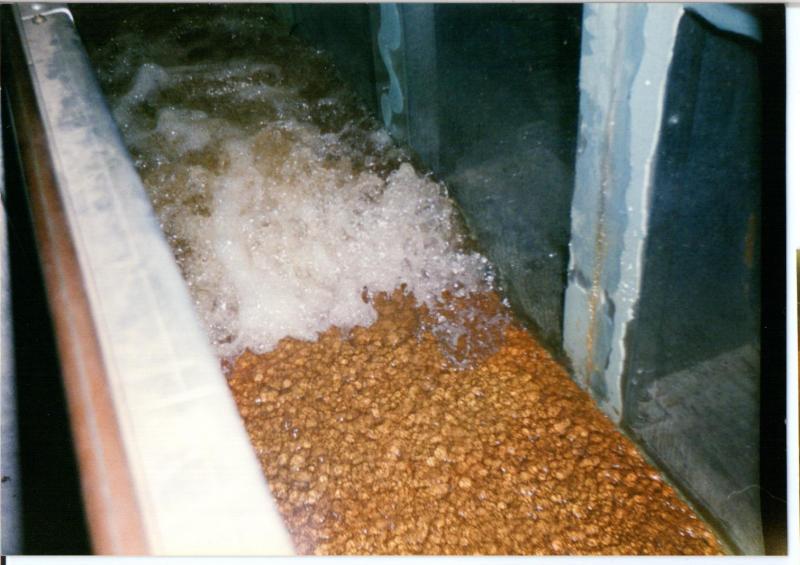Ali S. Fayad, Discoverer of The Explicit Alternate Flow Depth in Rectangular Open Channels
About Alternate Depths
With the August 1998 issue of CE News, Ali Fayad began announcing his discovery of the explicit form of the alternate flow depth in rectangular open channels and the sluice gate.
Downstream Depth/Upstream Depth=0.25Fr{Fr+(Fr2 +8)0.5 }
Here, Fr represents the value of the upstream Froude number of an idealized sluice gate.
- Fr=V/(g.y)0.5 , where V is the velocity, g is the gravitational acceleration, and y is the depth of flow
- Fr=q/(g.y3)0.5 , where q is the specific flow per unit width of channel
- Fr=(Q/b)/(g.y3)0.5 , where Q is the channel flow and b is its breadth
- Fr=(q/qc) , where qc is the critical flow for the same depth of channel flow
Therefore, there are many manifestations and permutations for the alternate flow depth. Different forms for the Alternate Flow Depth can be achieved with as little as a one step simple substitution of the various forms of the Froude number. Hence, the question is raised: What makes the Fayad Alternate Flow Depth unique and why express it in this order in the first place?
INTRODUCTION
The turbulent flow of water in a rectangular open channel has two alternative depths for the same specific energy level. The first pattern of flow is shallow with a high velocity value which results in a Froude number value that is larger than one. Its consequences are the speedy erosion of the bottom of the channel. This is known as supercritical flow. It responds to upstream control. The second pattern of flow is deep with a low velocity value and a corresponding Froude number below unity. Its flooding potential is high as the water may overflow the banks or edges of the channel. This is denoted by sub-critical flow. It responds to downstream control.
The aforementioned was described in many introductory textbooks on fluid mechanics and hydraulics (Roberson et al. 1990, Gupta 1995, Brater et al. 1976, Chaudhry 1993, AISI 1990). These books also described the phenomenon of the hydraulic jump by which water dissipated energy and attained a more stable flow. The closed form relationship for the sequent depths of the hydraulic jump had been available since a long time. On the other hand, until December 1997, an explicit form relating the alternate flow depths (with the same energy level) through a closed form solution, had been missing from the literature. This began to change with an inadvertent discovery made by the author in 1994.
CLOSED FORM SOLUTION
In 1986 the author developed a set of mathematical tools that were advanced and original for their time all in the area of structural analysis (Fayad 1987, Fayad 1992). Over the next decade the author gradually began using algorithmic compression to extend these mathematical tools and equations to flow mechanics. The discovery of the explicit form of the alternate flow depth in rectangular open channels was not truly a goal or objective for itself. The notation used in the ensuing discussion and solution is per Appendix II .
The subcritical and supercritical depths for the same quantity of flow and possessing the same energy are known as the alternate flow depths. In theory, they are presumed to occur upstream and downstream of an idealized sluice gate. The Fayad alternate flow depth relation (including both the real and imaginary root) as it was published in the December 1997 version of the MNEMOSYNE Fayad (copyright registered) software is:
------------------------------------------
-Channel is rectangular in cross-section.
-The fluid in the channel is water in unidirectional flow.
-Gravity forces are dominant, viscous forces are minor.
-Froude number: Fr<1 is subcritical flow, Fr>1 is supercritical flow.
-Alternate Flow Depth Calculations are based on A.S. Fayad's method of 1994.
-Alternate Depth= 0.5*(V^2)/(2*g){1+-sqr(1 + 8/Fr^2)} of upstream.
-The above A.S. Fayad explicit form of the alternate flow depth is applicable for frictionless turbulent flow.
------------------------------------------
This relates the flow downstream of the idealized sluice gate (supercritical) to the mean velocity and the Froude number upstream of the sluice gate (subcritical), and to the gravitational acceleration. This is also expressible as a function of the upstream depth
yd = 0.25yu . Fru2[ 1 + (1 + (8/Fru2 ))0.5]
This is further manipulated to give a dimensionless ratio of the downstream depth to the upstream depth:
yd / yu = 0.25{ Fru [ Fru + (Fru2 + 8 )0.5]}
CONCLUSION
The most compelling reason for using the explicit form of the alternate flow depth is that it does exist. This means that trial and error, graphical techniques, and approximations are no longer necessary to calculate the alternate flow depth. The simplicity of the explicit form reduces the hydraulic functional relationships for rectangular open channels to fewer distinct parameters. This is the core essence of engineering formulations.
APPENDIX I: REFERENCES
Roberson, J.A. and C.T. Crowe, Engineering Fluid Mechanics, Fourth Edition, Houghton-Mifflin Company, Boston, 1990.
Gupta, R.S., Hydrology and Hydraulic Systems, Waveland Press, Prospect Heights, Illinois, 1995.
Brater, E.F. and H.W. King, Handbook of Hydraulics, Sixth Edition, McGraw-Hill, N.Y., 1976.
Chaudhry, M.H., Open-Channel Flow, Prentice Hall, N.J., 1993.
Modern Sewer Design, Second Edition, American Iron & Steel Institute, 1990.
Fayad, A.S., "DSMS: A Unique Continuous Beam Program", Proceedings of The 5th National Conference on Microcomputers in Civil Engineering, Orlando, Florida, November 1987.
Fayad, A.S., "Influence Lines For Flexible Connections and Supports" Proceedings of The 10th National Conference on Microcomputers in Civil Engineering, Orlando, Florida, November 1992.
APPENDIX II: NOTATION
The following symbols are used in this paper:
y = Depth of the flow in the channel.
yd = Depth of flow downstream of sluice gate
yu = Depth of flow upstream of sluice gate
Fr = Froude Number.
Fru = Froude Number for flow upstream of sluice gate
RF = Fayad explicit form ratio = yd / yu
yd / yu = 0.25{ Fru [Fru + (Fru^2 + 8 )^0. 5 ]}
Q = Total flow quantity in the channel.
E = Energy of the flow per unit width of the channel.
q = Flow per unit width of the channel =Specific flow
q= Q/b
V = Mean velocity of the turbulent flow.
Vd = Mean velocity of flow downstream of sluice gate
Vu = Mean velocity of flow upstream of sluice gate
g = Gravitational acceleration.
b = Breadth of the channel.

Sluice Gate in Flume (CSUS 1994-2000)
CHANNEL: The Alternate Flow Depths
Water is discharged into a rectangular horizontal open channel with a base width of 1.5 ft. A stilling basin/headtank is used to stabilize the flow and reduce the turbulence upstream of a sluice gate which, in turn, regulates the discharge into the aforementioned channel. The upstream depth is measured at a height of 1.75 ft. above the bottom of the channel. The designer aims to minimize erosion of the bottom of the channel and aims to safeguard against flooding. The pump discharge is monitored by an electronic flow meter at 0.223 cfs.
Analyze with MNEMOSYNE
SOLUTION:
Geometric & Physical Properties
(a) total flow = 0.223 cfs, (b) upstream depth =1.75 ft, (c) breadth = 1.5 ft, (d)gravitational acceleration, for conventional units, is at 32.2 ft/s^2.
Results
(a) The upstream Froude =0.011317, (b)upstream mean velocity = 0.085 fps, (c)Specific energy of the flow =1.750112 ft., (d) the alternate flow depth =0.01406 ft., (e) the minimum specific energy for which the flow is possible = 0.132317 ft., (f) critical velocity =1.68535 fps, (g)critical depth = 0.0882 ft., (h)force on full area of sluice gate =138.78 lb.
Interpretation
The turbulent flow of water for an idealized sluice gate in a rectangular open channels has two alternative depths with the same specific energy level. The sluice gate's upstream flow pattern is deep with a low velocity value and a corresponding Froude number below unity. Its flooding potential is high as the water may overflow the banks or edges of the channel. This is denoted by sub-critical flow. The downstream pattern of flow for an unsubmerged sluice gate is shallow with a high velocity value and a Froude number value that is larger than one. Its consequences are the speedy erosion of the bottom of the channel. This is known as supercritical flow.
Verification
A Froude value less than unity is indicative of subcritical flow. On the other hand, a supercritical flow is known to occur when the Froude number exceeds one in value.
Sample Input/Output from Mnemosyne Fayad
------------------------------------------
OPEN CHANNEL: CRITICAL
[$] GIVEN INPUT: lb, ft
[Q] Total Flow = .223
[Y] Upstream y = 1.75
[B] Breadth: b = 1.5
------------------------------------------
OPEN CHANNEL: CRITICAL
`For the given flow depth, Froude # = 1.131693E-02
Per second velocity = 8.495238E-02
Unit Specific Energy = 1.750112
Unit Specific Force = 1.531642
`Alternate flow depth = 1.406013E-02
`Force on Control Surface between alternate depths = 138.7831
`For the given flow, Critical depth = 8.821121E-02
Critical Velocity = 1.685349
Minimum Specific Energy = .1323168
------------------------------------------
OPEN CHANNEL: HYD. JUMP
[$] GIVEN INPUT: lb, ft
[Q] Total Flow = .223
[Y] Upstream y = .01406
[B] Breadth: b = 1.5
------------------------------------------
OPEN CHANNEL: HYD. JUMP
`For the given flow depth, Froude # = 15.71476
Per second Velocity = 10.57373
Specific Energy = 1.750144
`For Theoretical Hydraulic Jump:
Conjugate flow depth = .3055188
Per second velocity = .4866039
Specific Energy flow = .3091956
Specific Energy Headloss within jump = 1.440948
------------------------------------------

Hydraulic Jump in Flume (CSUS 1994-2000)
CHANNEL: Hydraulic Jump
Water effusing from beneath a sluice gate is discharged at supercritical speed. This makes it unstable and prone to switching to a subcritical depth whenever an opportunity provides itself. The process and area of transition is known as the hydraulic jump. The discharge is maintained at 0.223 cfs. The initial depth preceding the hydraulic jump is sheet flowing at 0.01406 ft. The breadth of the rectangular horizontal channel is 1.5 ft.
Analyze with MNEMOSYNE
SOLUTION:
Geometric & Physical Properties
(a) total flow = 0.223 cfs, (b) initial depth =0.01406 ft, (c) breadth = 1.5 ft, (d)gravitational acceleration, for conventional units, is at 32.2 ft/s^2.
Results
(a) The initial Froude =15.715, (b) initial mean velocity = 10.5737 fps, (c)Specific energy of the flow =1.750144 ft., (d) the conjugate flow depth =0.3055 ft., (e) the specific headloss in the hydraulic jump = 1.441 ft., (f) The final velocity after the jump =0.4866 fps.
Interpretation
The initial Froude number is above 1 confirming that a hydraulic jump is theoretically possible under the given circumstances.
Verification
Energy in the form of turbulence is dissipated in the hydraulic jump.
Copyright 2012 Ali S. Fayad, Discoverer of The Explicit Alternate Flow Depth for Rectangular Open Channels. All rights reserved.
